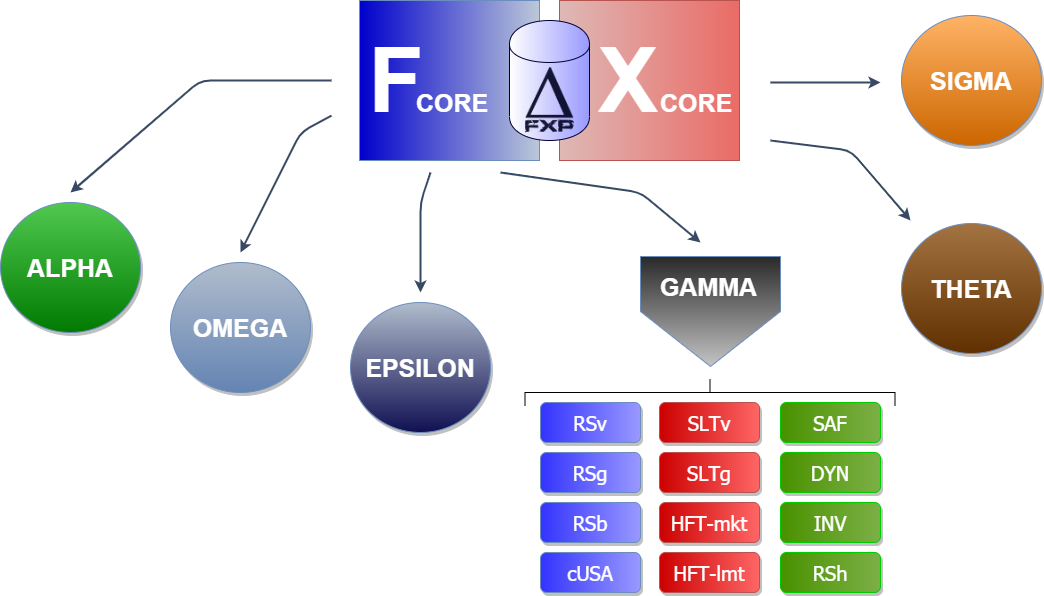

















































The novel concepts introduced by FX Physics are applied through entirely redesigned wavefunctions that extract the core
drivers of those specific price motion dynamics pertaining to each actively traded asset class. This universal yet
discriminating 'True Price Motion Dynamics' (TPMD) algorithmic architecture provides all systems with a singular
relevance as a trading solution. The base algorithm led to the birth of F_Core and X_Core which were respectively
applied to the Index Futures and Forex markets for their high liquidity, long trading hours, and ease of leverage. From
there, all other subsystems were derived and developed.
The TPMD mathematical framework may be non-trivial but its trading implementation is very simple, or rather, 'simplex' as I call it. Each system is assigned a set of trading rules that is exceptionally compact and straightforward. What the algorithm does is that it crunches numbers at the end of each price bar on any relevant time frame. It then outputs the trigger level at which the trader should buy or sell on the N-th price bar of the same given time frame. Such clarity and versatility provide the trader with a myriad of possible applications that range from intraday scalping to long-term portfolio investments, with trading costs setting the only limitation. The algorithm also proves low maintenance as its good working order requires minimal input and monitoring. The result is two-fold: an expectancy mapping of the market ahead of time and a real-time signal that is both quantified and actionable.
The TPMD mathematical framework may be non-trivial but its trading implementation is very simple, or rather, 'simplex' as I call it. Each system is assigned a set of trading rules that is exceptionally compact and straightforward. What the algorithm does is that it crunches numbers at the end of each price bar on any relevant time frame. It then outputs the trigger level at which the trader should buy or sell on the N-th price bar of the same given time frame. Such clarity and versatility provide the trader with a myriad of possible applications that range from intraday scalping to long-term portfolio investments, with trading costs setting the only limitation. The algorithm also proves low maintenance as its good working order requires minimal input and monitoring. The result is two-fold: an expectancy mapping of the market ahead of time and a real-time signal that is both quantified and actionable.
The FX Physics suite of trading systems is powered by 2 core algorithmic engines: F_Core and X_Core that are applied to
Index Futures and Forex trading, respectively; and of an additional 6 secondary engines, namely Omega, Epsilon, Sigma,
Alpha, Gamma and Theta applied to a wider array of investment vehicles ranging from Futures & Forex (including CFDs), to
Options, Equities and ETFs.
The suite is organized as follows.
The suite is organized as follows.
FX Physics' algorithmic engines are extremely versatile. They not only offer an edge in any market, they also provide an
investment solution that caters to every trader, be it in terms of frequency, risk-aversion, or the ability to trade on margin.
The table below summarizes these characteristics engine by engine.
The table below summarizes these characteristics engine by engine.
A brief description of the 6 systematic sub-engines follows.
OMEGA is a direct by-product of the F_Core engine that picks up price inertia. It is suitable for Index Futures as well as ETFs. It may be used as a stand-alone short-term strategy or can play a core role within a delta-one directional portfolio pegged to the SP500 index as its benchmark. With a trading logic going both long & short, it is the perfect instrument to claim that extra residual 'alpha' in bull markets and reduce volatility in bear markets.
EPSILON is a mean reversion sub-engine which is also derived from the F_Core engine, then reapplied to the Index Futures and ETF markets to help benchmarked portfolios beat the SP500 index on both risk and return. It capitalizes on a collective investor bias that causes recurring market 'errors' in the actual stretch of short-term movements. These errors are not frequent and the system typically yields only 8 trades per year. However, it captures those flawlessly with a staggering 83% winning rate. Unlike Omega, it is better suited as a low maintenance add-on strategy to complement a traditional portfolio since it trades less agressively and less frequently.
SIGMA is derived from X_Core. It is a niche sub-engine demonstrating the relevance of the TPMD algorithm on fast, intraday time frames and stands at the very frontier of profitability imposed by transaction costs and slippage. This short-term, volatility expansion sub-engine aims to capture the early stages of price fractals, typically the first 10% to 15% of a larger development. By doing so, it reaps the rewards of both sideways motion and jump diffusion even in case of the abortion of a fractal formation. It is also very useful to complement a longer-term strategy as it will typically relay it and smooth out its equity curve in times of seemingly flat markets.
ALPHA is a complete equity investment solution designed to improve on so-called 'Buy & Hold'. The sub-engine is totally dedicated to long-term ETF investing but adds a one-two twist to your regular passive strategy by both lowering volatility and increasing returns. First, it uses the TPMD algorithm as a market timing tool allowing it to arbitrage a portfolio of ETFs with maximum efficiency. Second, it uses a regime filter to single out bull & bear markets and keep the investor out of extreme market conditions. The system only trades long but may be expanded to futures and commodities in order to maximize decorrelation. It was backtested over 90+ years and has consistently beaten the SP500 index on both risk and return.
GAMMA encompasses a blend of 12 systems using the many capabilities of the TPMD algorithm. It is applied to highly liquid equities and ETFs by spotting fractal breaks and likely short-term reversals/continuations. Thanks to its embedded kill switch techniques, the engine's speculative nature is offset by its tight risk management and directional neutrality over time. Every day, week or month after the close, the algorithm scans the market for opportunities and yields a list of tickers to trade on the following day. For those traders wishing to be more aggressive, Gamma also easily allows scaling with the use of leverage. Lastly, its suite of systems offers a minimal impact on liquidity by focusing on highly liquid universes such as the SP500, SP100 and Nasdaq Composite indices. This low impact on liquidity is further reinforced by TPMD's non-parametric reliance allowing to spread executions across a wide array of market levels without sacrificing efficiency or performance.
THETA is a trading system that leverages the volatility modeling ability of the TPMD algorithm to accurately trade covered options or simply to improve timing on ETF and equity trades. On options, Theta indicates appropriate strike placement and optimal maturity up to 6 months ahead of time. It confronts realized vs implied vs expected volatility to find the flaws in the volatility density priced in by the options market, in particular as relates to the known flaws in the VIX index valuation beyond 30 days out. The results are always optimal annualized returns coupled with drastically reduced risks of assignments.
OMEGA is a direct by-product of the F_Core engine that picks up price inertia. It is suitable for Index Futures as well as ETFs. It may be used as a stand-alone short-term strategy or can play a core role within a delta-one directional portfolio pegged to the SP500 index as its benchmark. With a trading logic going both long & short, it is the perfect instrument to claim that extra residual 'alpha' in bull markets and reduce volatility in bear markets.
EPSILON is a mean reversion sub-engine which is also derived from the F_Core engine, then reapplied to the Index Futures and ETF markets to help benchmarked portfolios beat the SP500 index on both risk and return. It capitalizes on a collective investor bias that causes recurring market 'errors' in the actual stretch of short-term movements. These errors are not frequent and the system typically yields only 8 trades per year. However, it captures those flawlessly with a staggering 83% winning rate. Unlike Omega, it is better suited as a low maintenance add-on strategy to complement a traditional portfolio since it trades less agressively and less frequently.
SIGMA is derived from X_Core. It is a niche sub-engine demonstrating the relevance of the TPMD algorithm on fast, intraday time frames and stands at the very frontier of profitability imposed by transaction costs and slippage. This short-term, volatility expansion sub-engine aims to capture the early stages of price fractals, typically the first 10% to 15% of a larger development. By doing so, it reaps the rewards of both sideways motion and jump diffusion even in case of the abortion of a fractal formation. It is also very useful to complement a longer-term strategy as it will typically relay it and smooth out its equity curve in times of seemingly flat markets.
ALPHA is a complete equity investment solution designed to improve on so-called 'Buy & Hold'. The sub-engine is totally dedicated to long-term ETF investing but adds a one-two twist to your regular passive strategy by both lowering volatility and increasing returns. First, it uses the TPMD algorithm as a market timing tool allowing it to arbitrage a portfolio of ETFs with maximum efficiency. Second, it uses a regime filter to single out bull & bear markets and keep the investor out of extreme market conditions. The system only trades long but may be expanded to futures and commodities in order to maximize decorrelation. It was backtested over 90+ years and has consistently beaten the SP500 index on both risk and return.
GAMMA encompasses a blend of 12 systems using the many capabilities of the TPMD algorithm. It is applied to highly liquid equities and ETFs by spotting fractal breaks and likely short-term reversals/continuations. Thanks to its embedded kill switch techniques, the engine's speculative nature is offset by its tight risk management and directional neutrality over time. Every day, week or month after the close, the algorithm scans the market for opportunities and yields a list of tickers to trade on the following day. For those traders wishing to be more aggressive, Gamma also easily allows scaling with the use of leverage. Lastly, its suite of systems offers a minimal impact on liquidity by focusing on highly liquid universes such as the SP500, SP100 and Nasdaq Composite indices. This low impact on liquidity is further reinforced by TPMD's non-parametric reliance allowing to spread executions across a wide array of market levels without sacrificing efficiency or performance.
THETA is a trading system that leverages the volatility modeling ability of the TPMD algorithm to accurately trade covered options or simply to improve timing on ETF and equity trades. On options, Theta indicates appropriate strike placement and optimal maturity up to 6 months ahead of time. It confronts realized vs implied vs expected volatility to find the flaws in the volatility density priced in by the options market, in particular as relates to the known flaws in the VIX index valuation beyond 30 days out. The results are always optimal annualized returns coupled with drastically reduced risks of assignments.
First and foremost, because the TPMD algorithm relies on a single
hard-wired physics formula, it is agnostic to parametric
sensitivity and therefore works with zero optimization which is
the root of all evil in algorithmic trading. Absolutely no
curve-fitting was used to elaborate or fine-tune the F_Core and
X_Core source systems. For those subsystems which use
spectral optimization, algorithmic relevance and the very low
number of degrees of freedom ensures that profitability remains
maximal across a massive and stable array of inputs. In fact, it is
hard to find sets of parameters for which the systems do not
work! This feature alone sets TPMD way apart from the
competition. While most systems undergo heavy optimization to
barely work within a specific historical sample and a particular
set of parameters, others will claim to 'only' need periodic
re-optimization to hide the fundamental weakness of their
design. The fact is that ANY optimization used as a base system
architecture leads to failure. These locally optimized systems go
nothing further than throwing darts onto a wall and redrawing
the target around them. Anyone can hit the bull's eye that way.
For this very reason, these shaky systems will work wonders on
in-sample data but will degenerate miserably as soon as they are
thrown into the real world. Instead, by using the exact same
structure and set of trading rules even as volatility evolves,
TPMD delivers total performance consistency over and over,
whether backtested on historical data or trading on
live/out-of-sample data. The TPMD algorithm makes worrying
about parameters a thing of the past.
NON PARAMETER-CENTRIC
This feature is a direct benefit of TPMD not being parameter
centric. Because TPMD is not optimized, its universal trading
edge is smoothly transferable to any market with the same
relevance. Therefore, the core systems are naturally adapted to
other markets than Index Futures & Forex with no need for
further adjustment or specific tuning. Omega, Epsilon, Sigma,
Alpha and Theta are virtually oblivious to parametric settings and
will work across an infinity of inputs. Beware of systems
designed specifically for a predefined market or specific
parameters. In itself, this very clue screams 'optimization'. It
shows right away that the system is flawed, curve-fit, and will
not withstand the test of time.
MULTI-MARKETS
Because the TPMD algorithm does not rely on optimization, it can
trade profitably in whatever direction that the market takes it.
None of its trading systems are biased in any way to trade long
just because the data over which they were backtested was
bullish, or vice-versa. TPMD is indifferent to prior data and will
simply react in the way the market requires it to, without being
pre-conditioned. Only Theta was intentionally restrained to short
positions due to the very nature of its objective to sell volatility
by shorting options as a strategy typically used in tandem with a
broader, long-term, more traditional equity investment solution.
LONG/SHORT AGNOSTIC
Unsurprisingly, because of its independent behavior, the TPMD
algorithm generates profit that is largely or totally decorrelated
from the intrinsic performance of the underlying instruments that
it trades. As a result, any TPMD-based system may be used both
as a stand-alone investment solution, or as a way to diversify a
broader portfolio of more traditional instruments or systems in
order to smoothen or partially hedge overall performance.
SCALABLE DECORRELATION
Even the best trading system would be worthless if its
profitability relied on a few big moves followed by long stretches
of flat-lined equity progression, or by an otherwise steady
appreciation broken on many spots by steep drawdowns. What
we want instead is a smoothly rising equity curve, which
spreads out positive performance as evenly as possible through
time. Also, practice shows that a trader's discipline tends to
erode as sharp losses occur. A well-designed system will
therefore foster performance both through its own ability to
generate profit as well as by keeping intact the trader's
confidence in applying the rules to the letter. TPMD offers no
crystal ball and does generate drawdowns as any other
solution. However, these are kept to the bare minimum
relatively to returns both in terms of magnitude and duration.
There again, when it comes to consistency, TPMD delivers.
STABLE EQUITY CURVE
An algorithm may only be successful if its translation from the
drawing board to the trading blotter is free from clutter and its
execution is spot on. The FX Physics project aimed to keep it
simple from the start. The algorithm's core logic is made of a
few streamlined trading axioms that are extremely easy to
apply. The TPMD algorithm focuses on its reactive power by
mapping the market with a succession of trigger levels
maximizing positive expectancy. These trigger levels simply may
or may not be crossed. As such, TPMD-derived systems may be
implemented as 'set-and-forget' solutions where orders are
entered at the end of each price bar. The trader may then walk
away from its screens until the relevant price bar ends, thereby
keeping its involvement to a minimum.
LOW MAINTENANCE
NON-DISCRETIONARY
The TPMD algorithm obviously follows a 100% mechanical
process. There is zero guesswork involved in the execution, no
market analysis, no fundamentals etc... Absolutely no subjective
interpretation of the market is required for it to work. All that
the trader needs to do is obtain the trigger levels for the next
bar, enter the trade, and walk away. Only discipline is needed.
No pre-written money management is deemed as 'optimal' for
any system. Still, from the extensive backtesting of up to 100
years was derived a fairly accurate level of the maximum
expectable drawdown that a trader may sustain for any given
system. Not surprisingly, because of the algorithm's relevance,
the performance disparity within each market across each
system is relatively tight. Depending on the instrument that an
investor decides to trade, each position size may be scaled with
ease while knowing in advance what kind of drawdown is to be
expected in the worst case scenario. That flexibility needs to
work in tandem with defining for each investor what his own
risk-aversion and drawdown tolerance are. As a general
guideline, however, FX Physics' trading solutions target a
sustainable MAR Ratio of between 0.75 and 1.50, which is very
high by any standard.
FLEXIBLE MONEY MANAGEMENT
AUDITED LIVE TRADING
Backtesting is vital when it comes to assessing a system's
behavior and profitability. But nothing beats the test of live
trading that involves all the pitfalls of reality such as slippage,
actual limit fills, execution errors and trading discipline. Trading
FX Physics' systems live, whether on a simulated or a
real-money basis, should not come as an astonishing
commitment. In fact, this is the least that you could expect
from a trusted trading solution engineer. I believe that fairness
requires that the FX Physics project does not remain at the
stage of clever modeling, thorough backtesting, and
profitability claims. Instead, we go one step further in asserting
the algorithm's integrity by trading its systems live and building
long-term track-records. This genuine performance history is
audited by a third-party to relieve any doubt as it is made
accessible and transparent to anyone; with institutional
credentials only required to view real-money records. The goal
here is evidently to provide institutions and traders with an
authentic frame of reference to assess all performance claims
and realize how closely real trades replicate backtested
results.
NOT FOR SALE
Doesn't it sound profoundly antinomic that anyone with a
performing algorithm in a finite liquidity environment would be
willing to sell their edge? What kind of price tag would you put
on a legal license to print money? How would you calculate the
NPV of an infinite income stream? None of these questions ask
for a sensible answer. The industry is simple. Algorithmic trading
accounts for a massive proportion of the volume traded each
day and the major players spend huge sums of money each year
to develop their own algorithms. Right there, intellectual
property is paramount. The reason why the FX Physics project is
safely kept family-owned is no different. And the same principle
should hold true for any profitable system operating within tight
liquidity. By definition, the corollary is self-evident. Selling a
winning algorithm makes no economic sense if sharing it implies
less profit for its developer. And any system logic left up for sale
therefore 'must' either be a watered down version of the original
or outrightly flawed.
Those are the top 10 features that set the TPMD algorithm in another league when it comes to robustness, accuracy and simplicity.
Traders, investors, portfolio managers, brokers, advisors... risk-taking is our business. While securing capital protection at all
times, our duty as professionals is to grow equity. Reaching that goal requires making sense of randomness amid erratic
volatility, a confusing information flow and ever increasing sophistication of financial products. Finding a consistently profitable
edge in any market is crucial. FX Physics can help provide both buy side and sell side value. Here is how.
ABSOLUTE PERFORMANCE
CUT COSTS, BOOST FEES
BOOST REVENUE
VERSATILITY
CLIENT RETENTION
STRONG FIDUCIARY ETHICS
CONTROLLED RISK
LOW STRESS
GENERATE IDEAS
Uncorrelated trading logic to
profit in bull, bear, and
sideways markets. Retain
your credibilty as a pro.
Expand your expertise &
opportunities. Every market is
covered through 8 algorithmic
engines and a comprehensive
suite of 29 systems.
Skip the next bear market &
preserve your capital. All
systems come with tight risk
management & kill switches.
Cut your MIFID research
budget to a trickle as your
robust performance warrants
higher fees and attracts
larger AUM.
A value proposition with no
substitute limits switching.
Do you know many PMs able
to perform in ALL markets?
Rely on an absolute edge
tested over 300+ combined
years across 7 asset classes
and financial intruments.
Dial up portfolio turnover
without sacrificing your
client's performance.
Reliably determine suitability &
appropriateness thanks to a
predictable investment solution
that is finely tuned in with your
client's risk aversion &
expectations.
Keep up the deal flow. Call
your clients with numerous
quantified & actionable
trading ideas every single
day, in any market.
As featured in:
Our IT resources:
users, for an improved viewing experience, please flip to landscape mode.
v1.58.137 and beyond.
The following website is dedicated to algorithmic trading with applications expanding from the Forex market to any tradable asset class.
The FX Physics© algorithm, its F_Core© and X_Core© core systems, its Omega©, Epsilon©, Sigma©, Alpha©, Gamma© and Theta© subsystems, their future updates, as well as derived products, services and publications are the sole and exclusive intellectual property of its owner. The entire www.fxphysics.com website content is supported by international copyright laws. The illicit reproduction of all or any part of this website prior to any explicit authorization from its author will be strictly prosecuted. By entering this website, you willfully accept that anything that you may learn from it is for your personal use only. You unconditionally give up any right to share, resell or broadcast any of its trading related knowledge, analysis, techniques or signals.
All information posted on this website reflects the author's opinion and the opinion of its accredited participants, and may not be the truth. Please use your own good judgment and seek advice from a qualified consultant before believing and accepting any information posted on this website. The author of this website/algorithm/trading systems shall not, in any way whatsoever, be held responsible for the reliability or accuracy of the information available on this website. The content provided is put forward in good faith and believed to be accurate. However, there are no explicit or implicit warranties of accuracy or timeliness being made. FX Physics© and his author invite everyone to exercise their own discretion before committing their own funds to any trading strategy. As a result, FX Physics ©, his author and his contributors shall not, in any way whatsoever, be held liable for any adverse financial consequences caused directly or indirectly by the implementation of the presented systems, strategies, methods, processes, services, advice, tips, comments or any information contained therein.
Risk Warning! This website is neither a solicitation nor an offer to trade in the financial derivatives markets. Leveraged trading is a highly technical way of investing which carries a high level of risk. Therefore it may not be suitable for all investors as the use of margin creates large potential for gains but at least equally large potential for losses. Before participating in this type of trading, you should carefully assess your personal financial knowledge, investment objectives and risk tolerance. A substantial possibility does exist that you could sustain a loss of some, all, or even more than your initial investment. As a result, always trade with money that you can afford to lose. In particular, you should be aware of all the risks associated with Forex and Futures trading and seek advice from an independent financial advisor if you have any doubts.
CFTC Rule 4.41 Hypothetical or simulated performance results have certain limitations. Unlike an actual performance record, simulated results do not represent actual trading. Since these trades have not been executed, the results cannot completely account for the impact of certain varying trading factors such as transaction costs, slippage, execution delays or adhering to a particular trading discipline in spite of trading losses. These examples are some of the material points that may adversely affect actual trading performance and therefore cause the final performance to deviate materially from that stated in this website. Simulated trading programs in general are also subject to the fact that they are designed with the benefit of hindsight. No representation is being made that any account will or is likely to achieve profits or losses similar to those shown in the future.
The FX Physics© algorithm, its F_Core© and X_Core© core systems, its Omega©, Epsilon©, Sigma©, Alpha©, Gamma© and Theta© subsystems, their future updates, as well as derived products, services and publications are the sole and exclusive intellectual property of its owner. The entire www.fxphysics.com website content is supported by international copyright laws. The illicit reproduction of all or any part of this website prior to any explicit authorization from its author will be strictly prosecuted. By entering this website, you willfully accept that anything that you may learn from it is for your personal use only. You unconditionally give up any right to share, resell or broadcast any of its trading related knowledge, analysis, techniques or signals.
All information posted on this website reflects the author's opinion and the opinion of its accredited participants, and may not be the truth. Please use your own good judgment and seek advice from a qualified consultant before believing and accepting any information posted on this website. The author of this website/algorithm/trading systems shall not, in any way whatsoever, be held responsible for the reliability or accuracy of the information available on this website. The content provided is put forward in good faith and believed to be accurate. However, there are no explicit or implicit warranties of accuracy or timeliness being made. FX Physics© and his author invite everyone to exercise their own discretion before committing their own funds to any trading strategy. As a result, FX Physics ©, his author and his contributors shall not, in any way whatsoever, be held liable for any adverse financial consequences caused directly or indirectly by the implementation of the presented systems, strategies, methods, processes, services, advice, tips, comments or any information contained therein.
Risk Warning! This website is neither a solicitation nor an offer to trade in the financial derivatives markets. Leveraged trading is a highly technical way of investing which carries a high level of risk. Therefore it may not be suitable for all investors as the use of margin creates large potential for gains but at least equally large potential for losses. Before participating in this type of trading, you should carefully assess your personal financial knowledge, investment objectives and risk tolerance. A substantial possibility does exist that you could sustain a loss of some, all, or even more than your initial investment. As a result, always trade with money that you can afford to lose. In particular, you should be aware of all the risks associated with Forex and Futures trading and seek advice from an independent financial advisor if you have any doubts.
CFTC Rule 4.41 Hypothetical or simulated performance results have certain limitations. Unlike an actual performance record, simulated results do not represent actual trading. Since these trades have not been executed, the results cannot completely account for the impact of certain varying trading factors such as transaction costs, slippage, execution delays or adhering to a particular trading discipline in spite of trading losses. These examples are some of the material points that may adversely affect actual trading performance and therefore cause the final performance to deviate materially from that stated in this website. Simulated trading programs in general are also subject to the fact that they are designed with the benefit of hindsight. No representation is being made that any account will or is likely to achieve profits or losses similar to those shown in the future.
Copyright 2024 © FX Physics. All Rights Reserved.
GOVERNMENT-REQUIRED DISCLAIMER
Site Map
- Home
- About
- Track Record
- The Algo
- Trade
- Learn
- Shop
- Donate
- Privacy Policy
- Terms & Conditions
- About
- Track Record
- The Algo
- Trade
- Learn
- Shop
- Donate
- Privacy Policy
- Terms & Conditions
Optimized for
Web Design Tools
Partners
- FundSeeder
- Collective2
- Myfxbook
- Collective2
- Myfxbook
Trading Software
- MetaTrader 4
- TWS
- FX Synergy
- Amibroker
- TWS
- FX Synergy
- Amibroker
Brokers & IT
- Interactive Brokers
- ICMarkets
- Axitrader
- FXVM
- ICMarkets
- Axitrader
- FXVM
Get in Touch












